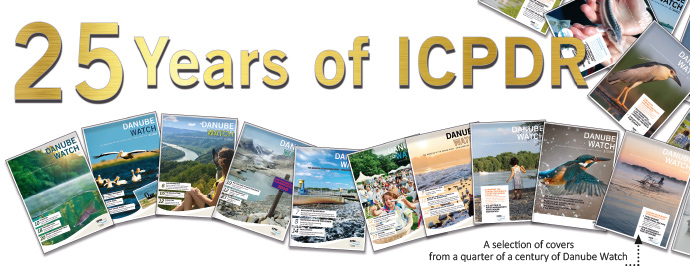Danube Watch 2/2019 - 25 Years of ICPDR

“The ICPDR is the principle international body for the promotion of a sustainable and balanced use of water resources in the Danube River Basin”, says Bosko Kenjic, Bosnia & Herzegovina's Head of Delegation to the ICPDR.
A round the world, the ICPDR is seen as a leader in river basin management, providing valuable lessons for the managers of other transboundary water systems from the Orange River to the Amazon. The ICPDR is also actively cooperating with global organisations such as the Global Environment Facility (GEF), the World Bank, United Nations Development Programme (UNDP), UN Environment and the Organisation for Economic Cooperation and Development (OECD), to ensure that other programmes can learn from the experiences of managing the Danube River Basin.
The Danube River Protection Convention (DRPC) was signed in 1994. Its signatories agreed to cooperate on crucial water management issues, including the conservation of surface and groundwater, controlling hazards from accidents and floods and reducing pollution entering the Black Sea from sources in the Danube River Basin. The Convention takes a holistic approach, based on the understanding that water resources play an essential part in ecosystems as well as in human societies and economies. In essence, the ICPDR was created to act as an organisation that works to ensure the sustainable and equitable use of freshwater resources in the Danube River Basin for the benefit of the over 80 million people who call the area home.
In the 25 years since then, the ICPDR has provided a means for countries to assess the health of the river and develop basin-wide plans to address priority issues such as pollution, hydropower, navigation and adaptation to climate change. By bringing together representatives from the highest ministerial levels, technical experts, members of civil society and the scientific community, the ICPDR has contributed greatly toward improvements in the state of water bodies in the Danube River Basin. This can be seen in the EU Water Framework Directive and Flood Directive. The Water Framework Directive (WFD) established a framework for community action in the field of water policy in 2000. Conceived of in 2004 and implemented in 2007, the EU Flood Directive aims to reduce and manage the risks to human health, the environment, cultural heritage and economic activity posed by floods.
The ICPDR serves as an important learning hub and platform for the exchange of experiences and innovation between countries faced with vastly disparate economic and environmental challenges. It also continues to pioneer inter-sectorial cooperation and structured dialogue among those who benefit from the Danube's water resources. This includes 24 observer organisations which are the Black Sea Commission, Carpathian Convention, Central Dredging Association, Danube Civil Society Forum, Danube Competence Center, Danube Commission, Danube Environmental Forum, DanubeParks, Danube Sturgeon Task Force, Danube Tourist Commission, European Anglers Alliance, European Barge Union, European Water Association, Friends of Nature International, Global Water Partnership, International Association for Danube Research, International Association of Water Supply Companies in the Danube River Catchment Area, International Hydrological Programme of the UNESCO, International Sava River Basin Commission, RAMSAR Convention on Wetlands, Regional Environmental Center for Central and Eastern Europe, VGB PowerTech e.V., viadonau and the Worldwide Fund for Nature – Danube-Carpathian Programme.
According to Heide Jekel – Germany’s head of delegation to the ICPDR – the ICPDR is "providing global leadership as one of the first river basin commissions to have developed a climate change adaptation strategy”.
The continuous goal of the ICPDR is to implement the Danube River Protection Convention and make it a living tool for coordinating sustainable and equitable water management. This includes conservation as well as the improved and rational use of water resources for the benefit of the Danube River Basin.
The ICPDR has achieved much in 25 years of existence toward tackling its key goals while growing, expanding and cooperating with an increased number of actors in the region. Below is only a small sampling of such achievements.
Addressing Pollution
Having cooperated in numerous joint efforts, the GEF Strategic Partnership, ICPDR, the European Commission and Danube countries can take credit for recent measurable improvements in the Black Sea’s north-west shelf. Nowhere on Earth have such demonstrable water quality and ecosystem improvements been observed in a large river and adjacent sea as in the Danube and Black Sea ecosystems over the last decade. The Black Sea is showing initial evidence of recovery. This is only one of many notable examples of cooperative success in the region.
Flood Risk Prevention
In 2004, the Action Programme for Sustainable Flood Protection for the Danube was released by the ICPDR. In 2015, the Danube Flood Risk Management Plan, which is based on the EU Floods Directive, was released. It focuses on the strategic management of flood risk across the entire river basin and compliments national flood risk management plans. The main goal of both of these actions has been to increase communication, cooperation and solidarity among the individual countries of the Danube region, which may be affected by flooding.
Sustainable Hydropower
In 2010, Ministers from the Danube countries mandated the ICPDR to trigger a broad discussion process with the hydropower sector and all relevant stakeholders with the aim of integrating environmental considerations into the management of new and existing hydropower plants. This led to the creation of Guiding Principles on Sustainable Hydropower Development, which in turn has put in place a common vision and practical recommendations for countries to improve the efficiency and environmental management of hydropower plants. The Guiding Principles document is also currently available in eight languages: Bosnian, Croatian, Czech, English, German, Slovak, Slovene and Ukrainian.
Climate Change
In 2012, the ICPDR was the first river basin commission in the world to develop a climate change adaptation strategy. At the 2010 Danube Ministerial Conference, Ministers asked the ICPDR to develop a Climate Change Adaptation Strategy for the Danube River Basin and Germany was nominated to be the lead country for the activity, thus setting things in motion. The ICPDR's basin-wide approach to climate change is now helping to provide water management information at the catchment scale so that countries can determine the most likely impacts and cooperate on suitable adaptation measures. This strategy was again updated in 2018 with several research studies, expert workshops on adaptation based on these studies and the broad cooperation of ICPDR experts, nominated experts and observer organisations.
Joint Danube Survey
The first JDS was carried out by the ICPDR in 2001 and was the most homogeneous analysis of the water quality and the ecological status of the Danube River ever conducted. Every six years since then, a JDS has taken place on ever broader and deeper scales, providing a wealth of valuable data from which informed high-level decisions regarding environmental measures can be made. These collaborative surveys have shown that the water quality is progressively becoming healthier and safer, in large part thanks to efforts supported by the ICPDR. 2019's JDS4 was kicked-off in June with ambitious goals and new methods including a more active role for national authorities and individual countries, effect based methods/ non-target screening, environmental DNA (eDNA) testing and information gathering on micro-plastic contamination levels in the Danube.
Outreach
From the beginning, the ICPDR recognised the importance of reaching out to and informing the public about its important work. Danube Watch magazine was first published in 1994 and has acted as the voice of the organisation ever since. In addition to Danube Watch, the ICPDR has taken full advantage of the internet by regularly publishing reports and information on its website while also utilising social media outlets to better reach the public. Public outreach also means physically bringing people together. To this end, the ICPDR regularly organises activities like the annual Danube Day – a tradition since 2004. See page 22-23 for an in-depth look.








